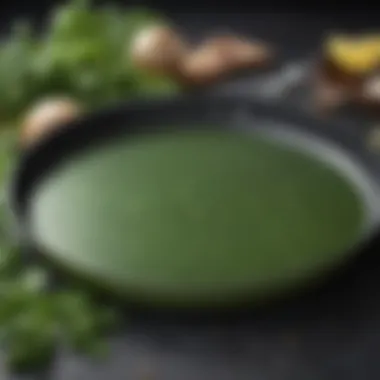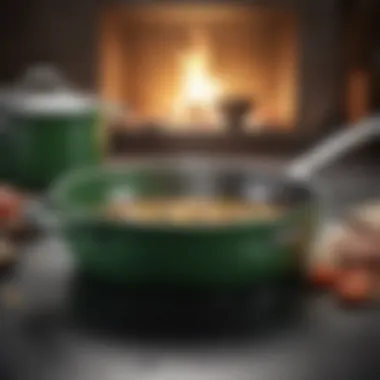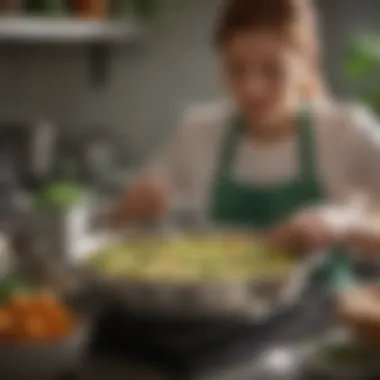Evaluating the Safety of Green Pans for Healthy Cooking


Intro
In recent years, the kitchen has become more than just a space for cooking; it’s where health-conscious choices take center stage. Among these choices, Green Pans have gained traction among those who prioritize eco-friendliness and safety. But just how safe are these popular non-stick pans? This exploration aims to unpack the layers of materials, chemicals—or lack thereof—durability, and user experiences related to Green Pans. It’s essential to understand whether adopting these pans can genuinely benefit both the environment and personal health.
Green Pans are marketed as a healthier alternative to traditional non-stick cookware, boasting a ceramic non-stick coating free from harmful substances like PTFE and PFOA. However, with the rise of concerned users delving deep into the safety considerations, it’s vital to assess the facts from multiple angles. This article sheds light on the intricate details of Green Pans, aiming for readers to make informed choices when stepping into their kitchens with such cookware.
By exploring various facets of Green Pans, including the materials used in their construction, health implications, durability, and environmental impact, we aim to provide clarity on whether they represent a prudent and safe option for everyday cooking. The dialogue around this cookware isn’t just based on personal stories; scientific insights and expert opinions offer a wealth of knowledge. As we unfold this narrative, we'll delve into each critical component, equipping readers with the necessary tools to discern the safety and efficacy of using Green Pans in their culinary adventures.
Preface to Green Pans
Cookware choices are like little snapshots of our cooking philosophies, revealing our values about health and safety. This article will detail the significance of Green Pans in modern kitchens, a staple for many who are conscious about their health and the environment. We will dissect the relevance of their composition and technology and how they intertwine with existing concerns over cookware safety, providing a broad view of these popular kitchen tools.
Understanding Green Pan Technology
The technology behind Green Pans pushes the envelope when it comes to non-stick cooking surfaces. These pans often utilize a unique ceramic coating that is marketed as free from harmful substances like polytetrafluoroethylene (PTFE) and perfluorooctanoic acid (PFOA).
This ceramic-based coating is designed to withstand high temperatures, making it a competitor to traditional non-stick options. It's worth noting, though, that just because it's ceramic doesn't mean it's impervious to wear and tear. Over time, even the best-made Green Pans can suffer scratches or degradation, affecting their performance. Thus, understanding this technology is crucial—it's not all sunshine and rainbows in the realm of green cookware.
Popularity and Market Position
Green Pans have carved out a significant niche in the cookware market. Available at numerous retailers, consumers have more access than ever to this eco-friendly alternative. They appeal especially to those wary of traditional non-stick skillets, which often come with safety concerns related to chemical exposure during cooking.
"Consumer demand for safer and more sustainable kitchen products has never been higher."
Their market position reflects broader consumer trends toward healthier cooking methods and a growing consciousness about environmental impact. Many people, especially health enthusiasts and eco-conscious consumers, have gravitated towards Green Pans, viewing them not just as a cookware option but as a lifestyle choice.
Composition of Green Pans
Understanding the composition of Green Pans is vital for grasping their safety and performance. These pans stand out in a crowded kitchenware market, drawing attention not just for their functionality but for their eco-friendly credentials. Knowing the materials and technologies behind these pans gives consumers insights into how they align with health needs and environmental concerns.
Materials Used
Green Pans are crafted from a specific combination of materials aimed at promoting health without sacrificing durability. The primary base material for many Green Pans is aluminum, known for its excellent heat conductivity. This metal allows for even cooking, reducing hot spots that can occur with lesser cookware.
However, not all aluminum cookware is created equal. Green Pans utilize a hard-anodized process, which contributes to a sturdy, scratch-resistant surface. Beyond that, the anodization helps prevent leaching of aluminum into food, a concern for some consumers.
Moreover, these pans employ a ceramic-based coating that is made from sand rather than traditional chemicals found in conventional non-stick products. This is a significant point of differentiation. Unlike Teflon, which can release harmful fumes when overheated, the ceramic coating is free from PTFE and PFOA, which have arisen as red flags for health-conscious shoppers. The absence of these chemicals reduces fears of potential adverse health effects, making Green Pans a safer choice for daily cooking.
Some might wonder about the long-term sustainability of these materials. In comparison to traditional non-stick coatings, Green Pans’ ceramic coating is designed to withstand higher temperatures, allowing for versatile cooking without degrading over time. It�’s essential to consider that while the initial investment might be steeper than standard non-stick pans, the durability adds to longevity, which can be economical in the long run.
"Choosing the right cookware is not just about convenience but making informed decisions on health and safety. Green Pans exemplify this approach by combining performance with eco-friendly materials."
Coating Technology
The coating technology employed in Green Pans is noteworthy for several reasons. At the heart of their design lies the ceramic non-stick coating, which is often promoted as a safer alternative to traditional non-stick materials. This technology offers a few key advantages.
First, this ceramic coating is inherently non-toxic. Unlike some non-stick coatings that raise alarm bells due to potential chemical releases during cooking at high temperatures, the coating used in Green Pans is stable and safe. This reassurance is critical for families and individuals concerned about food safety, especially when cooking at higher heat.
Second, the non-stick capabilities of the ceramic coating allow for cooking with less oil or butter, promoting healthier meal preparation. Many food lovers appreciate the ease of cooking that this technology facilitates. Cooking eggs or scrambling vegetables becomes an effortless task, with less likelihood of food sticking to the surface.
However, it is crucial to recognize that while ceramic coatings are touted for their safety and performance, they may not be entirely infallible. Users need to handle these pans with care; metal utensils can scratch the surface, compromising the non-stick properties over time. Moreover, while the coating is designed to handle high temperatures, prolonged exposure to extreme heat can degrade its effectiveness.
As with any cooking tool, proper care can prolong the life of the Green Pans. Following manufacturer instructions, using the right utensils, and avoiding sudden temperature changes can help maintain their condition.
In summary, the combination of high-quality materials and innovative coating technology positions Green Pans as a compelling option for those looking for safety without compromising on culinary performance. With health and environmental considerations at the forefront, understanding the composition of these pans empowers consumers to make thoughtful choices in their kitchen.
Health Concerns Related to Cookware


When it comes to what we use to cook our meals, the type of cookware plays a crucial role in our health. Kitchenware touches not just our food, but also our lives. The materials and coatings on pans and pots can have significant effects, both positive and negative, on our well-being. With the growing awareness of food safety and environmental issues, it's imperative to closely examine these elements when considering cookware choices.
The Non-Stick Debate
The convenience of non-stick cookware has transformed cooking for many. But there’s a catch; the safety of these surfaces is often hotly debated. Green Pans, with their ceramic coating, represent a shift from traditional non-stick materials. Unlike older models, which often contained polytetrafluoroethylene (PTFE) or perfluorooctanoic acid (PFOA), Green Pans avoid these compounds.
Here are a few key considerations in the non-stick debate:
- Healthier Cooking: The absence of PFOA and PTFE suggests that Green Pans minimize the risk of chemical leaching during cooking, especially at high temperatures. This can be beneficial for those wary of traditional non-stick options that can release harmful fumes under heat.
- Durability vs. Performance: Some users report that while Green Pans are often regarded for their eco-friendly appeal, they might not be as durable as their PTFE-coated counterparts. This durability concern raises questions about their longevity and long-term cost-effectiveness.
- Food Performance: What about how food turns out? Some chefs assert that while Green Pans excel at general cooking, they may require a learning curve, especially in achieving the same level of browning as a traditional non-stick surface.
In essence, the shift towards ceramic non-stick surfaces in Green Pans may appeal to a health-conscious audience, but it's important to balance these with performance needs in the kitchen.
Chemical Exposure from Cookware
Understanding the complexities of chemical exposure from cookware is essential. It’s not simply about what’s cooking on the stove; it’s also about what’s leaching into our food and the air. With traditional cookware, there is a concern around harmful chemicals entering the cooking environment, affecting both health and cooking quality.
- Leaching Concerns: There exists a fear that materials in cookware can leach into food, especially acidic ones, during cooking. The potential for contamination can drive consumers toward safer options like Green Pans.
- Environmental and Health Impact: With increasing pressure for manufacturers to address safety, many have moved towards producing cookware that is less harmful not just to us but also to the environment. For instance, Green Pans’ ceramic coating presents a shift meant to reduce potential health risks associated with conventional non-stick materials.
- Regulation and Transparency: As consumers become more conscious about what they use in their kitchens, there's a growth in demand for transparency regarding the materials and chemicals in cookware. This shift has prompted some manufacturers, including those of Green Pans, to comply with stricter regulatory standards, remaining accountable to health and safety.
"The cookware you choose can play a considerable role in maintaining your health and the environment, so make informed choices."
Evaluating the Safety of Green Pans
Evaluating the safety of Green Pans is a vital subject for anyone who seeks a healthier kitchen experience. Given the increasing spotlight on cookware materials and their potential health implications, understanding how Green Pans fare in this arena is crucial. Cookware isn’t just about aesthetics; it directly influences our meals and even our health. Hence, consumers deserve to know the nitty-gritty behind these popular pans.
When it comes to assessing safety, various elements come into play. One major aspect is the chemical composition of the pans. Knowing what’s actually inside these products can ease concerns about toxicity and long-term health effects. In addition, the adherence to regulatory standards cannot be overlooked; these guidelines help ensure that products meet safety requirements and are safe for everyday use.
Chemical Composition Analysis
The fabric of Green Pans is primarily dictated by their chemical makeup. Unlike traditional non-stick pans that often utilize polytetrafluoroethylene (PTFE) or perfluorooctanoic acid (PFOA), known for raising eyebrows among health-conscious individuals, Green Pans offer a more benign alternative. They generally feature a ceramic-based coating that claims to be free of hazardous chemicals.
A thorough chemical composition analysis reveals that Green Pans typically employ materials such as anodized aluminum, further eliminating the likelihood of harmful substances leaching into food during cooking. Notably, that ceramic layer not only confers non-stick properties but also resists scratching and peeling, which can often be a problem with other types of cookware.
"The use of ceramic coating in Green Pans signals a shift towards safer, more eco-conscious kitchen solutions."
Nutritional science backs the argument that using safer materials can lead to healthier cooking environments. When you’re not constantly worrying about potentially harmful chemicals, you can focus on preparing nourishing meals, which is what cooking should be all about.
Regulatory Standards Compliance
Another pivotal element in evaluating the safety of Green Pans pertains to their compliance with regulatory standards. In many countries, stringent norms exist to govern the manufacture and functionality of kitchenware. For instance, regulations by the U.S. Food and Drug Administration (FDA) and the European Food Safety Authority (EFSA) enforce guidelines to ensure that materials used in cookware are safe for contact with food.
Green Pans are often subject to such regulations, providing an important layer of reassurance for consumers. They need to pass toxicity tests and ensure that during normal cooking circumstances, no harmful substances will be released. Furthermore, reputable manufacturers transparently publish test results that demonstrate compliance with these standards. This approach not only enhances consumer trust but also encourages the market to adopt safer practices overall.
In addition to governmental standards, various certifications by independent authorities also guide consumer choices. Certifications like those from the NSF International signify that the cookware has met specific safety and performance criteria, providing an additional layer of security for potential buyers.
In essence, evaluating safety involves a multifaceted approach—one that brings together chemical analysis and regulatory oversight to provide a clearer picture of what consumers are placing in their kitchens. This layered examination creates informed choices for those looking to upgrade their cookware to something that promotes not only health but also peace of mind.
Practical Usage and Experience
When it comes to cookware, the practicality of use is often overlooked amid technical specs and material discussions. However, the everyday user experiences with Green Pans can provide a wealth of insights into their reliability and effectiveness in kitchen settings. Understanding these personal accounts helps prospective buyers make informed decisions. Here, we delve deep into the practical usage of Green Pans and what they really mean for home cooks.
User Testimonials and Insights
User testimonials are the lifeblood of any product assessment, providing first-hand accounts that can either bolster or undermine a product's reputation. Many Green Pan users share a common sentiment – the non-stick performance is spot on. Cooking eggs? They slide right off. Searing chicken? Non-stick success. Users often highlight how the ease of cleaning is a game changer. A quick rinse or a wipe with a sponge, and the pan is good as new.
However, not all experiences are sunshine and rainbows. Some users report that without proper maintenance, the non-stick quality can degrade over time. Pans that are overheated regularly might lose their charm. One user shared, "I had to learn the hard way that these pans don’t like high heat; now I use them on medium and get much better results." This emphasizes the importance of not just usage but also the nuances of proper care.
Additionally, many testimonials discuss their satisfaction regarding health-related features. As potential buyers are more health-conscious, hearing from fellow users about the "peace of mind" they get from using Green Pans, which are free from harmful chemicals, is noteworthy.


Common Issues and Solutions
No product is perfect, and Green Pans are no exception. While user testimonials often sing praises, some common issues have surfaced. Some consumers noted that after intensive use, the finish may show signs of wear. The question is – how do you solve that?
- Proper Cooking Techniques: Avoid cooking on high heat. Stick to medium settings to prolong the lifespan of the non-stick surface.
- Dedicated Utensils: Using metal utensils can sometimes scratch and damage the coating. Switching to silicone or wooden utensils can mitigate this risk.
- Cleaning Techniques: Some users mistakenly use abrasive sponges that can lead to scratches. A gentle foam sponge typically does the trick without harming the surface.
Despite these hiccups, many users find that Green Pans hold up quite well when treated with care. A large number of consumers recommend these pans for their low-maintenance nature and efficiency in day-to-day cooking tasks.
"It’s a culinary companion for the long haul. Just learn to love medium heat, and they’ll serve you well." – A satisfied Green Pan user.
In the realm of practical usage, it’s the interaction between product and user that shapes the narrative. Green Pans are gaining traction, not just because they manage to pull off healthy cooking, but because they fit seamlessly into the daily lives of those who choose them. Their usability, when paired with understanding and proper handling, can transform your cooking experience considerably without breaking the bank.
Comparative Analysis with Other Cookware
In the world of culinary tools, choosing the right cookware can be as tricky as picking the best ingredients for a recipe. Each type comes with its own set of advantages and drawbacks, which can greatly affect cooking experience and outcomes. Here, we examine how Green Pans stand in relation to traditional non-stick options and cast iron, two popular choices in the kitchen. This section helps to highlight essential distinctions that may guide consumers in making informed decisions based on their cooking style and health considerations.
Green Pans vs. Traditional Non-Stick
The traditional non-stick cookware, often coated with polytetrafluoroethylene (PTFE), has long been a favorite among home cooks. While it serves its purpose well, modern awareness around the potential health risks associated with PTFE—particularly at high temperatures—has shifted many to look for alternatives, like Green Pans.
Green Pans, on the other hand, utilize a ceramic-based coating free from PTFE and perfluorooctanoic acid (PFOA). This is a game changer because it addresses health concerns while delivering a non-stick experience. Here are a few factors to consider when evaluating the two:
- Health and Safety: Traditional non-stick pans can release harmful fumes if overheated. Green Pans don’t share this risk, providing peace of mind for health-conscious cooks.
- Durability: While traditional non-stick cookware can scratch easily and may need replacing every few years, Green Pans boast more resilience against wear. However, they still require proper handling to avoid chips in their ceramic coating.
- Cooking Performance: Many chefs have noted that Green Pans achieve similar cooking results in terms of non-stick performance. Foods brown nicely without sticking, making it a solid option for cooking enthusiasts.
"Choosing the right cookware is like finding the perfect partner; it should enhance your cooking experience, not complicate it."
Green Pans vs. Cast Iron
When we pivot to cast iron cookware, we enter a world of robust durability and flavor enhancement. Cast iron is well-loved for its ability to retain heat, making it ideal for frying and browning. However, it also demands a certain level of maintenance that can be off-putting for some, especially those looking for low-effort cooking solutions.
- Weight and Usability: Cast iron skillets are notoriously heavy and can be cumbersome for some. Green Pans are lighter and often easier to handle, making them more suitable for those who may struggle with heftier items.
- Seasoning Needs: Cast iron requires periodic seasoning to maintain its non-stick properties and prevent rust. Green Pans eliminate this need, providing a user-friendly option for those just starting in the kitchen.
- Flavor Effects: Cooking with cast iron can lend a unique flavor to dishes, especially if it is well-seasoned. This is something Green Pans can't replicate. Some dishes, particularly slow-cooked ones, may benefit from the unique properties of cast iron as opposed to a ceramic alternative.
In essence, while both Green Pans and cast iron offer unique benefits, they cater to different cooking styles and preferences. A novice might appreciate the simplicity of Green Pans, while a seasoned chef could cherish the depth of flavor from cast iron. Understanding these differences is key to making the right choice, ensuring that your kitchen experiences align with your cooking goals.
Environmental Impact of Green Pans
The environmental impact of cookware is an essential facet to consider amid growing concerns about sustainability and ecological responsibility. Green Pans, which are marketed as a healthier and more environmentally friendly alternative to traditional non-stick options, prompt curiosity over their actual ecological footprint. Exploring how these pans affect our planet— from how they are made to what happens when they are no longer usable— is crucial for informed purchasing decisions. In this section, we will focus on sustainable manufacturing practices and end-of-life considerations related to Green Pans, scrutinizing their contributions, benefits, and any points of contention that may arise.
Sustainable Manufacturing Practices
Green Pans pride themselves on using sustainable manufacturing techniques designed to minimize their ecological impact. Several key points underline their commitment to a more responsible approach:
- Use of Eco-Friendly Materials
Green Pans are produced using materials that aim to reduce harm to the environment. Rather than relying on harmful chemicals often found in traditional non-stick coatings, Green Pans utilize a ceramic coating that is free from PTFE or PFOA, which are common culprits in health and environmental discussions. This ceramic coating makes the production process less toxic. - Energy-Efficient Production Processes
The manufacturing of Green Pans employs energy-efficient methods that lower carbon footprints. Some manufacturers have adopted cleaner technologies that reduce electricity consumption and greenhouse gas emissions. This proactive step highlights a desire to contribute positively to climate change mitigation efforts. - Reduction of Waste
Certain brands focus on minimizing waste during production and can recycle leftovers or unused raw materials, contributing to a more sustainable supply chain. This aspect serves to lessen the amount of waste that typically ends up in landfills, thereby addressing a significant environmental concern.
It's easy to appreciate the appeal of cookware boasting eco-friendly credentials. Still, it's essential to dig deeper and assess if the claims hold up under scrutiny.
End-of-Life Considerations
How cookware is disposed of at the end of its life can inspire serious ecological ramifications. With the increasing trend of sustainability, understanding how Green Pans fare once they've reached their expiration date is of paramount importance.
- Disposal and Recycling
Unlike traditional non-stick pans, which often consist of materials that may not be recyclable, Green Pans promoted a more curated end-of-life plan. Some brands have started initiatives to facilitate recycling old pans, turning waste into new products. However, the availability of these programs may vary based on geographic location and specific recycling centers' capabilities. - Environmental Degradation
While Green Pans are designed to be more sustainable, improper disposal still poses risks if they end up in landfills. When not adequately disposed of, even eco-friendly cookware can contribute to soil and water pollution. This aspect underscores the need for consumers to be aware of proper disposal methods to support the environment. - Consumer Responsibility
Encouraging responsible consumer habits represents a crucial aspect of managing end-of-life scenarios. Education about how to recycle or properly dispose of old cookware can promote healthier environmental behaviors among users.
"Sustainability doesn't stop at purchasing green products; it extends into how we treat them at the end of their lifecycle."
From eco-conscious manufacturing processes to critical end-of-life management, the environmental impact of Green Pans emerges as a multifaceted topic. The balance between sustainable practices and consumer habits can significantly influence the overall efficacy of these products in contributing positively to ecological systems.
Expert Opinions


When evaluating Green Pans as a safe cookware option, the insights from those who work with food daily can provide an invaluable perspective. This section will delve into the opinions of culinary professionals and health experts, shedding light on the practicality and safety of these green alternatives in kitchens worldwide.
Insights from Culinary Professionals
Culinary professionals, including chefs and kitchen equipment reviewers, often have a unique lens through which they assess cookware. Their hands-on experience lends considerable weight to their evaluations. Many chefs appreciate Green Pans for their effective non-stick properties without the toxic concerns associated with traditional non-stick coatings. For example, a chef might note that food releases easily from the surface, reducing the need for excessive oil or butter, which has health and flavor benefits.
It's also worth mentioning that some chefs report that these pans heat evenly, a crucial factor in achieving perfect sears and browning. This even heating can be particularly important for culinary techniques like sautéing or pan-frying. A chef from a renowned culinary school expressed that with care, Green Pans hold up well over time, showing resilience even against metal utensils when needed. This longevity can make them more cost-effective than other cookware options that may require more frequent replacement.
"For those committed to healthier cooking, these pans have the potential to change the way we cook and how we think about cookware." – Chef Maria Torres
However, not everything is gold in the kitchen with these pans. Some culinary experts caution that while they perform well, the longevity can vary by usage patterns. Frequent high-heat cooking might wear the surface down quicker than anticipated, leading to reduced effectiveness of the non-stick surface. Chefs often recommend following the manufacturer's guidelines tightly; this includes avoiding the use of metal utensils and opting for softer tools made from wood or silicone to prolong the life of the pans.
Health Experts' Perspectives
Diving into the realm of health, experts express a mix of enthusiasm and caution regarding Green Pans. Health professionals, including nutritionists and dietitians, acknowledge the importance of making informed cooking choices. These experts highlight that the materials used in Green Pans avoid several harmful chemicals such as toxic PFOA and PFOS commonly found in traditional non-stick options. In a time where people are increasingly conscious of the chemicals they ingest, these pans provide peace of mind for many.
Moreover, some health experts underline the benefit of using these pans to reduce the overall fat and oil consumption in meals. By allowing food to cook without sticking, individuals can create healthier meals without compromising on flavor. A dietitian recently shared, "Healthy cooking starts with smart choices in cookware. Green Pans certainly align with those goals."
Still, there’s caution advised. Health experts remind consumers that the effectiveness of any cookware is often dependent on how well it is maintained. Improper cleaning or accidently scratching the surface can potentially reduce its safety. Furthermore, experts recommend monitoring cooking temperatures; even though Green Pans are designed to withstand higher heats, prolonged exposure to extreme temperatures can lead to degradation of even the safest materials.
Epilogue: Are Green Pans Safe?
In recent years, consumers have increasingly turned to Green Pans as a healthier alternative to traditional cookware. This shift reflects a growing awareness about health, safety, and environmental considerations in our daily lives. As we probe deeper into the question of whether Green Pans are safe, it's essential to highlight specific elements that play a crucial role in their evaluation.
One significant aspect is the materials used in the construction of Green Pans. Unlike standard non-stick pans that are often coated with potentially harmful chemicals, Green Pans employ a ceramic-based technology that claims to be free from toxic substances like PFAS, lead, and cadmium. This factor alone can be a game changer for many health-conscious consumers, especially those worried about chemical leaching during cooking.
Furthermore, we must consider the durability and performance of these pans. While the promise of non-stick functionality is appealing, it also raises questions about longevity and effectiveness over time. A safer product is only valuable if it withstands the test of time in regular cooking scenarios. Thus, understanding the operational lifespan and how they react to high heat is paramount.
In summary, assessing the safety of Green Pans involves looking at a combination of materials, manufacturing practices, and real-world usage experiences. Consumers can make informed decisions only if they are well-informed about these aspects.
Final Thoughts on Safety and Usage
As we wrap up this exploration, it's important to bring attention to the fact that safety isn't a standalone issue—it's intricately tied to how we actually use these products in our kitchens. Factors such as cooking temperature, type of food, and even cleaning methods can influence how safe, effective, and long-lasting Green Pans turn out to be.
Understanding the nuances of usage can prevent unfavorable outcomes. For instance, using metal utensils on the pans, even if they’re deemed scratch-resistant, can still result in wear. Familiarizing oneself with recommended practices ensures that the pans maintain their performance and integrity longer.
Recommendations for Consumers
For those considering investing in Green Pans, here are a few key recommendations:
- Research: Take a moment to read reviews and experiences shared by other users. This can offer insights into potential concerns or advantages.
- Follow Guidelines: Always adhere to the manufacturer’s instructions regarding cooking temperatures and maintenance. This ensures you get the best performance out of your cookware.
- Check Certifications: Look for relevant certifications that reinforce claims around safety. Often, manufacturers will provide evidence of compliance with industry standards.
- Experiment Wisely: When starting with a new cooking pan, try lower heat settings and monitor your results. This not only preserves the coatings but also improves your cooking techniques over time.
Remember, making a choice in cookware is not merely about looking for the latest trend; it’s about aligning those choices with a lifestyle that values health and sustainability.
Links to Relevant Studies
To inform decision-making, it’s essential to look beyond manufacturer claims and delve into scientific studies. Research can provide a wealth of understanding about how materials and coatings in cookware affect health and safety. Here are some links that can guide readers to credible studies:
- Wikipedia on Cookware Safety: A comprehensive overview of the safety concerns surrounding different types of cookware, including environmental impacts.
- Britannica's Overview of Non-Stick Cookware: Articles that explain how non-stick coatings work and their safety evaluations.
"Research is a lighthouse; it guides us through the murky waters of ingredient concerns."
Scholarly articles often highlight the chemical make-up of cookware. They play a vital role in comprehending safety across different brands, shedding light on seemingly safe products that could harbor hidden risks.
Where to Purchase Green Pans
Once the reader has absorbed crucial information about safety, the next step is purchasing. Green Pans, known for being safer and more environmental-friendly, can be found in various outlets. Understanding where to buy them is equally significant:
- Amazon: A go-to for many, it offers a wide range of Green Pan products with user reviews that can aid in decision-making.
- Target: Known for practical shopping experiences, they often have promotional sales that make buying cookware easier on the wallet.
- Walmart: Offers a variety of Green Pan options at competitive prices, plus local availability means you might avoid shipping costs.
- Direct from Green Pan's Official Website: This ensures you receive the latest models, and sometimes, exclusive discounts are offered only on their platform.
While purchasing, look for certifications such as PFOA-free, which can usually be found on product labels. Consumers should also consider reviewing warranties and return policies to make a fully informed purchase.
In summary, taking the time to explore such additional resources can empower users with knowledge and confidence when selecting and using Green Pans. The integration of research studies and careful purchasing strategies promotes a thorough understanding of the cookware's usefulness and safety.







